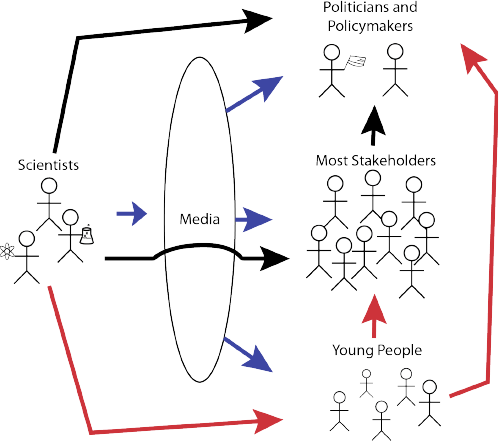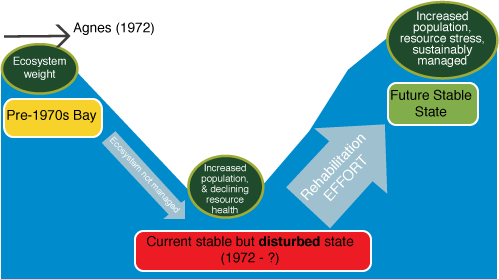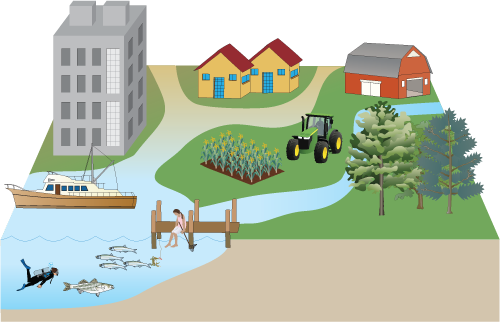Managing for Sustainable Ecosystems: Our Human Role
Maureen Brooks, Melissa Day, Katie Lecorchick ·Humans depend on ecosystems, whether for food, shelter, work or recreation, and these interactions are universal. We are the key ingredient to managing ourselves and rehabilitating ecosystems in order to maintain natural functions. Ecosystem-Based Management (EBM) uses the principles of sustainability, precaution, adaptation and integration (Boesch 2006) as a guide for better management so we can have healthy ecosystems for ourselves and future generations.
As the world industrialized and the human population increased, healthy ecosystems started becoming scarce. We must become aware of our impacts and manage ourselves. The concept of EBM would allow us to achieve sustainability by recognizing the human element, acknowledging complexity of systems, understanding cumulative impacts of multiple stressors, and then acting accordingly (e.g. McLeod et. al. 2005, UNEP 2011). Managing resources involves researchers, stakeholders, economists, media outlets, policy makers, politicians and the public. But most of all, EBM involves communication and effort (Fig. 1). We must learn to rehabilitate these ecosystems, communicate our knowledge to each other, plan and evolve our efforts (Lee 1999). The goal of EBM is a healthy, sustainable ecosystem that is resilient and able to provide the ecosystem services valued by stakeholders (McLeod et al. 2005). Communication must overcome the disconnects in knowledge and foster trust between scientists, managers and stakeholders.

Resilience is conceptually useful for communicating management goals. This concept helps us think about how resistant a system is to change, or how quickly it returns to equilibrium after disturbance (Carpenter et al. 2001, Walker et al. 2004). Models can be used to help evaluate resilience and make informed decisions. For instance, models can help manage toward functional and productive ecosystems able to withstand storms or sea-level rise.
The EBM approach is place-based, and implementation must be mindful of local culture and history. The initial wake-up call to the Chesapeake Bay region was Tropical Storm Agnes in 1972 which caused a large disturbance with slow recovery. The public and politicians noticed ecosystem-wide issues that scientists were already becoming aware of. This public attention led to political action. The slow response of the Chesapeake to management changes is an example of how a system can be quite resilient in a degraded state, requiring a high amount of effort to rehabilitate (Figure 2).

Management efforts for Chesapeake Bay have evolved through the years. An active adaptive management approach, where new policies are applied, monitored, revised and re-implemented (Lee 1999) has not explicitly been undertaken in the region yet (Boesch 2006, Boesch and Goldman 2009). Adaptive management comes with substantial costs, and so requires the political will and financial backing to continue monitoring and updating on a fixed schedule, and acceptance that the time investment will be higher than conventional approaches.
One controversial tool in EBM is the precautionary principle, where action must not proceed until it has been proven to be safe. Used often where human health is at stake, it aims to prevent situations that cause harm. If it is applied indiscriminately it can prevent anything new from being done at all, and so analysis of cost/benefit should be done before invoking it (e.g. Foster et al. 2000). This approach is most useful when considering new activities.
Ignoring some human influences while trying to manage others can yield unpleasant surprises, such as in attempts to manage Lake Mendota, Wisconsin. Farmers were not motivated to participate in reducing nutrient loads into the lake. Managers tried biomanipulation of the lake’s food web to improve water quality. This tactic was successful for a few years until “unexpected intensification of fishing pressure took a heavy toll” and combined with poor erosion control on lake-area construction projects, reestablished a degraded state (Carpenter et al. 2001). Integration is crucial for effective ecosystem-based management. This also highlights the need for “smart development” because it is one of the biggest challenges to EBM this century (Boesch and Goldman 2009, McDonough and Braungart 2002).

Integration should bring together managers, scientists, and stakeholders. Local, state, and federal agencies as well as NGOs need to work in a coordinated way. Even within the scientific community there should be integration among disciplines and collaboration between natural and social scientists and economists. As discussed previously, it is important to engage early and often with all stakeholders to help avoid conflict.
Complete ecosystem-based management is not feasible; however these concepts of resilience, sustainability, precaution, adaptation and integration should not stop us from making a best possible effort toward management. The rewards are healthy ecosystems, able to provide for the needs of the humans that interact with and live within them for generations to come.
President Obama is expected to mention a climate change initiative in his 2013 State of the Union address on 12 February (Washington Post Editorial board 9 Feb 2013). By acknowledging to the nation and the world that we need to prepare for climate change, ecosystem management and sustainability could become common household topics of conversation.
References
Boesch, D. F. (2006), Scientific requirements for ecosystem-based management in the restoration of Chesapeake Bay and Coastal Louisiana, Ecological Engineering, 26(1), 6–26, http://dx.doi.org/10.1016/j.ecoleng.2005.09.004.
Boesch, D. F., and E. B. Goldman (2009), Chesapeake Bay, USA, in Ecosystem-Based Management for the Oceans, edited by K. McLeod and H. Leslie, pp. 268–293, Island Press.
Carpenter, S., B. Walker, J. M. Anderies, and N. Abel (2001), From Metaphor to Measurement: Resilience of What to What?, Ecosystems, 4(8), 765–781, http://dx.doi.org/10.1007/s10021-001-0045-9.
Foster, K. R., P. Vecchia, and M. H. Repacholi (2000), Science and the Precautionary Principle, science, 288(5468), 979–981.
Lee, K. (1999), Appraising adaptive management, Conservation ecology, 3(2), 3. [online] URL: http://www.ecologyandsociety.org/vol3/iss2/art3/
McDonough, W and M. Braungart. (2002), Cradle to Cradle: Remaking the Way We Make Things. North Point Press, New York.
McLeod, K. L., J. Lubchenco, S. R. Palumbi, and A. A. Rosenberg (2005), Scientific Consensus Statement on Marine Ecosystem-Based Management. Signed by 221 academic scientists and policy experts with relevant expertise and published by the Communication Partnership for Science and the Sea at http://compassonline.org/science/EBM_CMSP/EBMconsensus.
UNEP (2011), Taking Steps toward Marine and Coastal Ecosystem-Based Management - An Introductory Guide. /publications/taking-steps-toward-marine-and-coastal-ecosystem-based-management/
Walker, B., C. S. Holling, S. R. Carpenter, and A. Kinzig (2004), Resilience , Adaptability and Transformability in Social – ecological Systems, Ecology and Society, 9(2), 5.
The Washington Post Editorial board. (2013 Feb 09). “Climate change and the president” The Washington Post. Retrieved from URL: http://www.washingtonpost.com/opinions/climate-change-and-the-president/2013/02/09/317db2fa-7239-11e2-a050-b83a7b35c4b5_print.html
Authors
M.T. Brooks, M. Day and K. Lecorchick
Next Post > Top ten fish and shellfish symbols: Sharks, rays, fish, crabs and lobster larvae
Comments
-
Bill Nuttle 11 years ago
Ok, I get it. The scientist going off to deal with the media has a beer in his hand, for "attitude adjustment," I suppose, or maybe it is an effort to meet the media on their own turf. I just hope that that is a flower that the scientist is holding who is going off to meet the young people.
-
Dale Booth 11 years ago
I think this sums up a lot of the challenges of Environmentally Based Management very nicely. I am curious if anyone has made an attempt to quantify the benefits of this approach numerically?
-
Atika 4 months ago
Thank you for sharing this great information with us, i really appreciate your post!